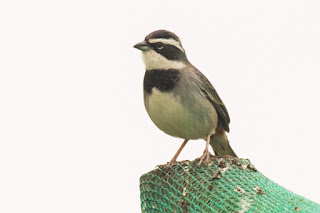Peter writes...
Last November I was fortunate enough to visit Peru at the invitation of
PROMPERU, the country’s tourism authority. The plan was that I might at some later date, as a result of that trip, take a group of birdwatchers to Peru for
Avian Adventures. Well, last month that plan came together and I led an Avian Adventures tour to the north of Peru and to the Andes and Machu Picchu.
The tour began with an early morning KLM flight from Birmingham to Amsterdam followed by a 12-hour flight to Lima. It wasn’t nearly as bad as it sounds with comfortable seats, plenty of legroom and in-flight food and entertainment both of a good standard. I managed to watch three movies!
We arrived at Jorge Chávez International Airport more or less on time at around 6:00 pm, passed quickly through immigration formalities and picked up our bags without fuss. Unfortunately, traffic in Lima was dreadful and it then took about an hour to get to our hotel in Miraflores, which is described as “an exclusive residential and upscale shopping district south of downtown Lima”. However, it had been a long day and by the time we had checked in there was no appetite for anything other than sleep!
To enable us to acclimatise and recover from the long flight we spent our first day in Peru birding in areas close to Lima. Our local guide was Gunnar Engblom, owner of
Kolibri Expeditions. I had been birding with Gunnar on the last day of the November trip and had met him again recently at the Birdfair at Rutland Water.
We began by driving to a wetland area, Humedales Puerto Viejo. This provided some easy birding to get us started – ducks, herons, cormorants, shorebirds and just a few passerines. Highlights were the colourful Peruvian Meadowlark and Many-colored Rush Tyrant, a dozen or so Grassland Yellow Finches and numerous Black-necked Stilts and Wilson’s Phalaropes.
Many-colored Rush Tyrant
Black-necked Stilts
Later we went to Lomas de Asia, a relatively new birding site that seems set to become a popular destination for visitors to Lima. Lomas is the name given to fog-watered vegetation in the coastal desert, a region that experiences little or no rainfall and is otherwise devoid of plant life. Lomas de Asia is essentially a fog oasis. We spent a couple of hours here during which we saw Burrowing Owls, a Black-chested Buzzard-Eagle, Vermilion Flycatchers and a number of species that weren’t seen again during the tour. Several of these were attracted to a small reservoir and to various puddles around the parking area. They included Band-tailed Sierra Finch, Raimondi’s Yellow Finch, Collared Warbling Finch and Chestnut-throated Seedeater. Particularly notable were the Thick-billed Miners, a species that is endemic to Peru. Several of them were very confiding and they were probably used to finding food around the picnic site where Gunnar and his driver, Renzo, prepared our second breakfast of the day! While we waited for food we occupied ourselves trying to identify the various hummingbirds that came by. Gunnar named them as Amazilia Hummingbird, Peruvian Sheartail and, appropriately, Oasis Hummingbird. These were just the first three of more than 50 hummingbird species that we would see in the next two weeks.

Band-tailed Sierra Finch
Burrowing Owls
Thick-billed Miner
Vermilion Flycatcher
Grassland Yellow Finch
Collared Warbling Finch
From Lomas de Asia we drove back north to Pucusana, a small fishing town where we saw hundreds of small boats anchored in the shelter of the harbour. They were a colourful sight but thankfully, Gunnar recognised them as a sign that we probably shouldn’t go ahead with the boat trip he had planned – conditions out at sea were a bit rough! In reality this was no big deal although it did mean that we would have to be content with seeing Humboldt Penguins from a distance, which after only a short while we did. From the cliff top we also watched Inca Terns, Red-legged Cormorants, Peruvian Pelicans and Peruvian Boobies. Along the sandy shore were Ruddy Turnstones, Belcher’s & Grey-headed Gulls and Blackish Oystercatcher. Inca Terns were also hanging around the fish market, even perched on the market stalls in the manner of gulls rather than terns. They really are unusual birds with their dashing curly white moustaches. They are placed in the monotypic genus
Larosterna, a name that seems to imply a combination of gull and tern.
Belcher's Gull
Blackish Oystercatcher
Inca Tern
Peruvian Pelican
All in all it was an excellent start to our tour; during the day we visited several other sites and recorded about 70 bird species.
More to follow…

















No comments:
Post a Comment